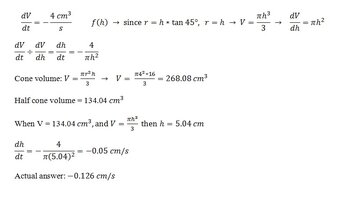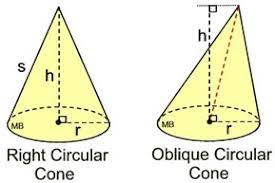Aminta_1900
New member
- Joined
- Sep 19, 2022
- Messages
- 38
Hi,
This question pertains to comparative rates of change. The way I am working out the question below is similar to one of the examples given before the exercise begins in my textbook, so I may be taking it too literally.
Somewhere I have gone wrong, so I hope someone can kindly look at my workings out and find the discrepancy.
"A container in the form of a right circular cone of height 16 cm and base radius 4 cm is held vertex downward and filled with liquid. If the liquid leaks out from the vertex at a rate of 4 cm^3/s, find the rate of change of the depth of the liquid in the cone when half of the liquid has leaked out".
By "right circular cone" I take it to mean with an angle of 90deg at the vertex.
My workings....

Many thanks for your time.
Neil.
This question pertains to comparative rates of change. The way I am working out the question below is similar to one of the examples given before the exercise begins in my textbook, so I may be taking it too literally.
Somewhere I have gone wrong, so I hope someone can kindly look at my workings out and find the discrepancy.
"A container in the form of a right circular cone of height 16 cm and base radius 4 cm is held vertex downward and filled with liquid. If the liquid leaks out from the vertex at a rate of 4 cm^3/s, find the rate of change of the depth of the liquid in the cone when half of the liquid has leaked out".
By "right circular cone" I take it to mean with an angle of 90deg at the vertex.
My workings....

Many thanks for your time.
Neil.

